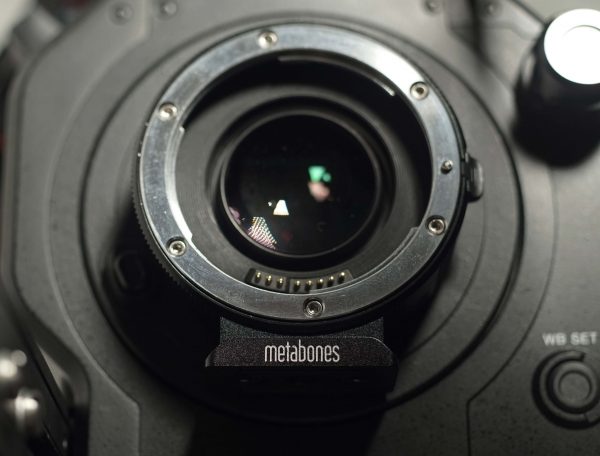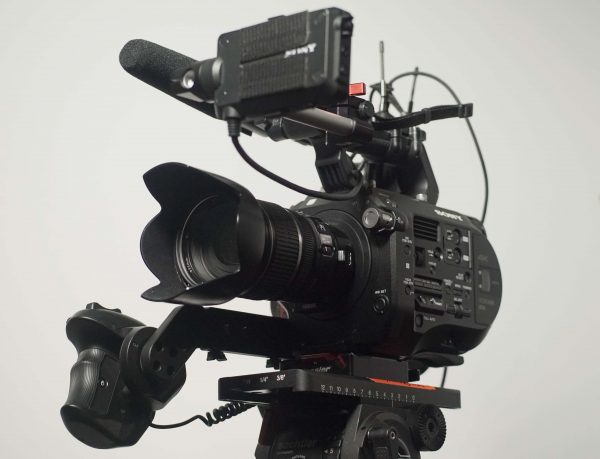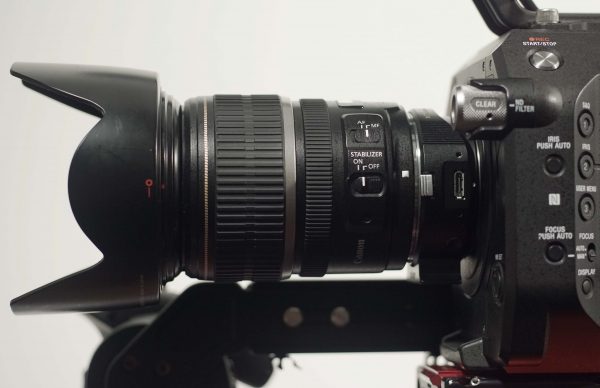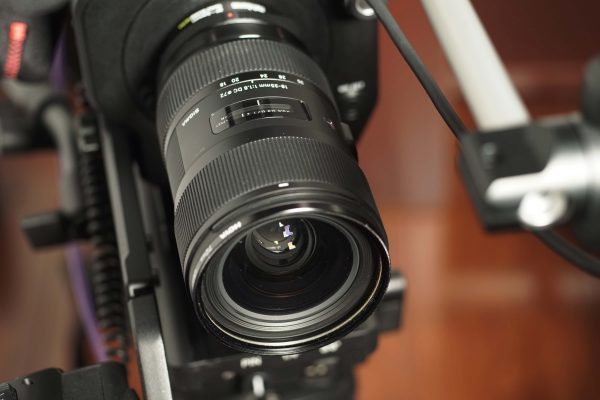By site editor Dan Chung:

When the Sony FS7 was announced I imagined it would be pretty straightforward to get EOS lenses to work on the E-mount camera using the beautifully made Metabones adapters. What’s more, there was the tantalising prospect of getting a full-frame look by adding a Metabones Speedbooster focal length reducer. These options greatly added to the draw of the camera.

When my FS7 arrived I was eager to test out my EF lenses. I already had the older generation MKII and MKIII of Metabones EF to E-mount Smart adapters, but I also ordered the newest MKIV and the brand new Speedbooster Ultra. These were electronically controlling the aperture on my little Sony a7S just great and I had no reason to doubt they would function well on my new camera. (Autofocus with all Metabones adapters and Sony E-mount cameras is unbearably slow and so I would only ever recommend using manual focus).
The MKIV Smart adapter and Speedbooster Ultra:
Putting the new Smart adapter MKIV and Speedbooster Ultra adapters onto my FS7 for the first time I made an unpleasant discovery – they do not work as I had anticipated. The iris behaves in a way that I find unusable for my style of run-and-gun shooting and completely differently to how the same adapters work on my other Sony E-mount cameras. To complicate matters further, the different Metabones adapters I tested behaved differently to each other. Each has its own unique issues when used in combination with the FS7.
There are two modes of operation on the MKIV adapter and the Speedbooster Ultra – Green mode and Advanced mode. These offer different functions and are selected at the time you put the adapter onto the camera.
Green mode is the default setting out of the box and when you use it with the FS7 the iris opens and closes quite rapidly when rotating the iris dial on the camera or handgrip. This would be perfect apart from one major issue – when you open the iris from a small aperture to a larger one, the iris blades open all the way to max aperture and back down again with each adjustment. The result on the image is that you get a momentary ‘flash’ each time you open up the iris. Below is a video that shows exactly what goes on inside the lens when it ‘flashes’.
This is clearly useless if you are trying to tweak the iris while rolling. When running-and-gunning there are many times when you might need to open up the iris a little and not lose the shot, such as transitioning from a dark room to an exterior, or tilting from a dark foreground to a bright sky. These are never my favourite shots, but for run-and-gun you never know when you might need to do them.
This is known to Metabones and this is what their support site says:
“Q. When I open up the iris the footage becomes very bright momentarily before going back to normal. Is there a problem?
“A. This is as designed. To resolve this problem, use the Advanced mode instead. The Metabones “Green” mode emulates a LA-EA1 adapter and the Metabones “Advanced” mode emulates a native E-mount lens. Sony’s own LA-EA1 exhibits the exact same “flicker” behaviour when opening up the iris. Whenever the camera opens the iris it always goes all the way to wide open first, and then stops down to the selected aperture, for both Sony LA-EA1 and Metabones in Green mode.”
Advanced mode doesn’t have these issues with ‘flashing’ but has other problems due to its emulation of an E-mount lens on the FS7. As I previously reported, E-mount lenses have ridiculously slow iris control that requires multiple turns of the control dial in order to change just one f-stop. I find this slow iris change to be even more unusable for run-and-gun shooting than the Green mode.
To make matters worse the Advanced mode needs to be engaged each time you attach a new lens. To do so you must remove the adapter from the camera, mount the new lens, then remount the combo while pressing a button on the side of the adapter. Should you not do this the set up will likely revert to Green mode. This is a real pain – especially as longer lenses really need the adapter to be secured via the support that Metabones provides. Thus to change lens means disengaging the lens support, removing the whole lens/Metabones setup and then putting it back together – clearly impossible during a fast moving shoot.
Metabones did release a new version of the firmware for the MKIV and Speedbooster Ultra while I was testing, but it seemed to make little or no difference with my EF lenses. It seems the firmware was mainly designed to give better compatibility for Zeiss ZE lenses.
Another annoyance is that sometimes the lens and adapter are not ‘seen’ by the camera. There seems to be no clear pattern to this, but for some reason when the lens/adapter combo is mounted the iris is not controlled and the value is not displayed. This can be a real pain and usually has to be fixed by turning the camera off and on again. Best practice would be to only change lenses while the camera is off – however, engaging Advanced mode requires that the camera be on when the lens is mounted. Even turning the camera off and on does not always cure the issue – like I said it is unpredictable.
There are also problems with certain lenses. In particular, my Canon 50mm f1.2L will not open or close iris at all with the Speedbooster Ultra adapter in either mode, but oddly it works with my Smart Adapter MKIV – even though the two adapters have the same generation of firmware. The latest 16-35mm f4L IS and 24-70mm f4L IS also have issues with erratic apertures. I have heard reports of similar problems with the Canon 85mm f1.2L. Other third party lenses I have seem buggy too.
I did have reasonable luck with the Zeiss 55mm f1.4 Otus. The iris behaviour was similar to the Canon lenses but there were no iris misreporting errors – I assume this is thanks to the recent firmware fix by Metabones.
So those are your two options with the MKIV and Speedbooster Ultra – a ‘flashing’ iris, or a slow iris which requires you to remove the adapter and hold a button every time you change lens. If you only ever shoot in a slow and controlled manner then this will probably be manageable – but for real world news, events and documentary shooting I just don’t think it is a workable solution.
Metabones are aware of the problems I have found while testing the latest adapters and sent me this by email:
“The FS7 is newly launched to market by Sony. So far we didn’t run any compatibility tests of our products with FS7. We will be sure to do so ASAP. We will try our best to increase our product compatibility and provide the new firmware to user for upgrade once it is ready. Please stay tuned.”
I find it interesting that they had not tested the FS7 with their adapters prior to the cameras release – it would appear there isn’t as close a link between Sony and Metabones as we might have hoped.
The MKII Smart adapter solution:
There is however a better solution from Metabones – if you can get hold of it. My copy of the older MKII EF to E-mount Smart adapter with version 0.16 firmware works much better with the FS7 than the newer ones. When mounted this adapter has reasonably rapid control of iris and does not have the ‘flashing’ issue of the newer models. It is quite usable (with most lenses) and this is the adapter I have been using for my most recent shoots.

The iris control still isn’t quite as positive as you would find on a Canon C300 or 100, there is a slight lag in adjustment that can be frustrating and inconsistent. Sometimes changing the value requires two turns of the dial – other times three. The aperture adjustment is also quite ‘steppy’ and not as smooth as a Sony lens. Even so, it is much better than the MKIV Smart adapter or Speedbooster Ultra. Occasionally the lens and adapter are not recognised, but I would say this is far less frequent than with the newer adapters. You can see this behavior in test video of the Canon 50mm f1.2L.
I’m going to speculate that this is because the MKII adapter (firmware version 0.16) emulates the LA-EA2 Sony A-mount to E-mount adapter which doesn’t ‘flash’ – rather than the older LA-EA1. Also, be aware that there are different firmware versions of the MKII adapter and it has to be returned to the factory for firmware updates.
Most modern Canon lenses I have tested on the MKII so far seem to work, with the exception of the 24-70mm f4L IS which has the same erratic aperture behaviour as on the newer adapters (oddly the even newer 16-35mm f4L IS didn’t appear to exhibit the same issues). This is unsurprising as the lenses are much newer than the adapter itself.
The experience is less good with other non Canon lenses like the Sigma 18-35 f1.8 which I tested. Iris misreporting was an issue as was the camera not ‘seeing’ the adapter. As with the Speedbooster Ultra and MKIV adapters I had more success with the Zeiss Otus 55mm f1.4. I also found the diminutive Voigtlander 20mm f3.5 worked reasonably well. If you have results for other lenses please feel free to post below in the comments.

I also tested an original Metabones Speedbooster running v0.16 firmware. I found it to be similar to the MKII adapter but with slightly more erratic iris behaviour. It also seemed to lock up more often than the MKII Smart adapter.
My suspicions are that the differences in behaviour between the original Speedbooster and MKII adapter are due to slightly different hardware, but I can’t be sure. To check your Metabones firmware version you can follow the procedure here.
Conclusions:
Let’s hope Metabones can solve the MKIV and Speedbooster Ultra compatibility issues quickly with new firmware.
There are several other third party EF to E-mount lens adapters out there on the market but sadly I haven’t had a chance to test them – I’ll have to leave that to others.
For now the best EF lens solution I can recommend is to try and find an older MKII adapter either from old stock or used. There were several on Ebay last time I checked – but be quick…





